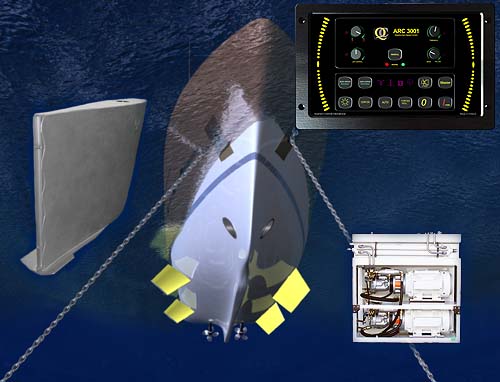By: REG POTTERTON
Timing and
fin speed are
critical
elements
for achieving
optimal OAS.

| STABILITY AT ANCHOR By: REG POTTERTON Timing and fin speed are critical elements for achieving optimal OAS. |

|
| QME’s founder and president, John Allen, tracked down
Boadicea's captain, Bob Peel, while the boat was rounding
Scotland, and asked him if the Koop OAS system had
been as effective as he had heard. Peel replied that while
it worked well enough he had not had much reason to
use it. A few more questions were enough to persuade
Allen, a skilled engineer in the hydraulics and stabilizer
field, that he had found a promising and largely unexplored
market. He set to work on developing new fin
designs, quieter hydraulics and more efficient control
technology for the production of QME-designed OAS
systems to be installed in new builds. Allen was thoroughly familiar with Koop products, having been that company’s exclusive North American distributor for several years, and he had long since identified limitations in Koop controls that required Quantum to make significant modifications to achieve optimal performance. When Boadicea was launched, Koop controls were more than a decade old, and in designing a new control for OAS Allen approached the man who invented the first one, Hans Ooms. Ooms agreed that the controls he made for Koop were outdated. He also told Allen that he planned to leave Delft University and form his own company in Holland to develop the next generation of software-based control systems. His work resulted in a family of controls under the ARC (Adaptive Ride Control) brand that is currently supplied by Quantum for conventional stabilizer systems, OAS and ride control systems. Allen’s only competition in the OAS business came from Vosper-Thorneycroft subsidiaries Naiad and KoopNautic (the latter acquired by Vosper in 1998); between them the three companies control 80 per cent of the world stabilizer market. As one of Europe’s oldest-established defense and civil contractors, the Vosper Group employs upwards of 7,000 and in its annual report for 2001 listed orders for $1.16 billion. Quantum, with a total staff of 25, had taken on a powerful rival. Having Hans Ooms aboard would help restore the balance. |
As of early March, 2002, there were two boats with
Koop OAS systems installed: Amels’ 230’ Boadicea,
and the 194’ Pegasus from Oceanco.
Naiad/Koop have taken orders for nine more of their
OAS systems, two of which are conversions in existing
boats, the rest in new builds. These are all scheduled
for delivery later this year and in 2003. Thus the Vosper
subsidiaries had a total of two OAS systems in service
and 11 pending.
Available anecdotal evidence about the effectiveness of the Quantum system comes from the 10 yachts that have been retrofitted with OAS control, some of them with the Koop control as modified by Quantum, the majority with the control designed by Hans Ooms. Unfortunately—from the perspective of appraising the effectiveness of in-service controls installed by the main contenders in the OAS market—the only evidence presented comes from yachts fitted with Quantum controls. Of the two Koop OAS yachts in service at time of writing, Boadicea was in dry dock at Amels. A message left by this writer with a crew member failed to elicit a response from the captain about the yacht’s OAS performance. This left Pegasus as the only other in-service source for information about Koop OAS performance, but the captain of Pegasus declined comment. (YIM will publish inservice performance results for Koop/Naiad OAS controls when these are made available.)
Go To Page 3 |
| NOTE: We have used the generic designation OAS (On Anchor Stability) to avoid repetition of the proprietary acronyms used by Naiad/KoopNautic (DATUM, Dynamic Adaptive Technology for Universal Motion control) and by Quantum (ARC, Adaptive Ride Control). | Magazine Article in a 270K PDF Adobe Acrobat file. |
| Broker John DeCaro |
| Fort Lauderdale, FL 33316 USA |
| Telephone: 954-671-0107 |
| info@buyexploreryachts.com |
| HOME | DESIGN | BROKERAGE | CREW | NEWS | F.A.Q.s | BIO | LINKS | EM@IL |